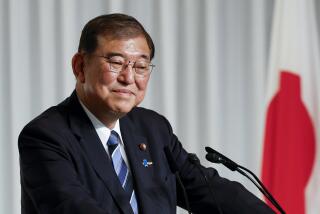Critic of U.S. Bases Loses Okinawa Vote
TOKYO — Residents of Japan’s southernmost island, Okinawa, the linchpin of the U.S. military presence in Asia, narrowly voted out the longtime incumbent governor Sunday after he had vigorously opposed U.S. bases there and elected in his place a businessman who may be more conciliatory to American interests.
Keiichi Inamine, 65, who had focused his campaign on reviving the economy, squeaked by Gov. Masahide Ota, 73, whose main platform was ousting the U.S. bases. The vote was 374,833 to 337,369.
Ota, who was seeking a third term, took office in 1990.
Inamine is backed by Japan’s ruling Liberal Democratic Party, which should help smooth long-strained relations between the national government, which has supported the bases, and the U.S.
The national government had made no secret of its unofficial preference for Inamine, indicating that if Ota was defeated, the prefecture would get more money, said John Neuffer, a political analyst at Mitsui Marine Research Institute in Tokyo.
“Because Ota was running the show, it was clogging up the money pipeline to Okinawa, Japan’s poorest prefecture,” Neuffer said.
The U.S. Embassy in Tokyo declined to comment on the results.
The base issue is likely to be on the agenda during President Clinton’s scheduled trip to Japan for meetings with Prime Minister Keizo Obuchi on Thursday and Friday. Okinawans have protested long and loud against the bases because of jet noise, traffic and the conduct of some of the military personnel stationed on the island. Tensions exploded in 1995, when three U.S. servicemen were involved in the rape of a 12-year-old girl. About 85,000 residents on the island of more than 1.2 million took to the streets to protest.
The conduct issue came to the fore again just weeks before the election, when a young woman was killed in an Oct. 7 hit-and-run accident caused by an allegedly drunk serviceman.
The governor’s race already has wreaked some havoc with U.S. defense policy. Just before the election, Tokyo appeared to have dismissed a U.S.-backed plan to build a floating military helicopter facility off the island. The heliport had been agreed upon by Tokyo and Washington as part of a plan to reduce the number of U.S. military facilities in Okinawa.
Although both candidates opposed the heliport, Ota took a far harder line. He wanted the helicopter facility moved out of the prefecture entirely and advocated relocating it to Guam or Hawaii.
Inamine, however, took a more flexible stance, proposing that a U.S. Marine air base now located in Futenma be relocated to the northern part of the island. He also proposed building a civilian airport that could be used by the U.S. military for 15 years.
But finding a place to put such a facility will be difficult, with opposition likely at whatever site is chosen.
Inamine focused his campaign on rebuilding Okinawa’s economy, where per capita income is the lowest in Japan. With little industry, the island suffers the highest unemployment rate in the nation: 8.7% in September, or more than twice the national average.
Okinawa has the largest number of U.S. military personnel in Japan. About 27,000 of the 47,000 U.S. personnel in Japan are based there.
More to Read
Sign up for Essential California
The most important California stories and recommendations in your inbox every morning.
You may occasionally receive promotional content from the Los Angeles Times.










